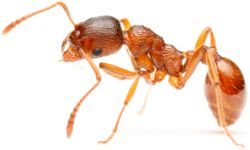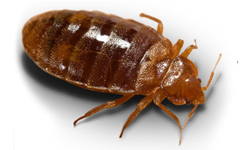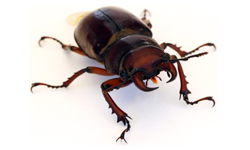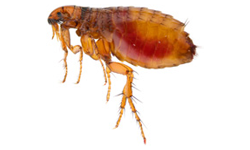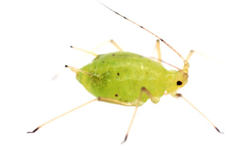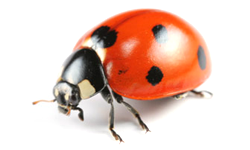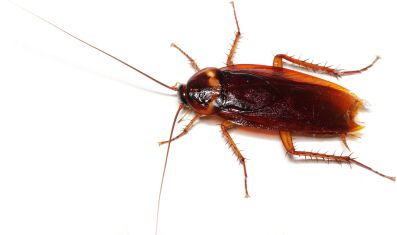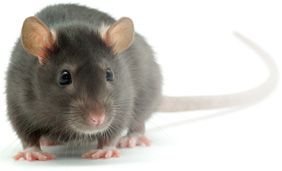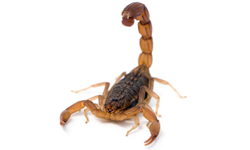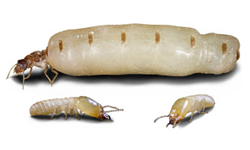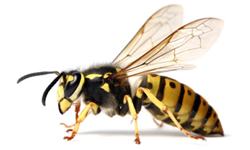Bug Database
Ants
Looking for information on ants in South Florida? You have found the right place on the web! Ants are amazing creatures, but they can be real pests! There are about 20,000 different species of ants known on Earth, and they can be found in almost every environment; especially in hot and humid South Florida.
These pests range from the tiny, essentially harmless Ghost ant (also commonly referred to as the “sugar ant”) to the ferocious and prolific Fire ant that deliver a bite that literally feels like you’ve touched fire. Ant mounds can damage lawns and landscaping and contaminate food, food preparation areas, and invade pet food bowls when they make their way into your home or business. They may be small, but they make up for their size in numbers; if you spot one ant, be certain there are many, many ants; long trails of ants busily moving back and forth around the food site and the surrounding areas. Their small size makes them very difficult to keep outside as they are constantly foraging for food.
Ants have a three-part segmented body, three pairs of legs, and live in a colony with many other individuals of the same species. Ants, along with bees and wasps, are members of the order Hymenoptera. All ants are in the family Formicidae, which is divided into a dozen or so subfamilies.
Winged ant reproductives, called alates or swarmers, leave the nest in large numbers in warm weather to mate and establish new colonies. They are often mistaken for termites that are similar in appearance and also exhibit this behavior. The way to tell them apart is by appearance, since the ant’s body is thin and constricted, whereas the termites body is straight-sided. Ants also have two pairs of long narrow wings that are firmly attached; the termite wings, which are similar in appearance, break off easily. If termite swarmers have been crawling, their broken wings litter the swarm area (which is also a good indicator of termite infestation, especially if found indoors). Ants have elbowed antennae, while termites have straight, beaded antennae.
Food preferences vary among ant species, but almost all ants are attracted to sweets. Honeydew, the sweet excretion of aphids and scale is highly favored by many ant species. Some, such as Argentine, Ghost, and White-footed ants actually tend or “farm” these insects, protecting them on the plant they eat and driving off any predators or parasites in order to secure a constant honeydew supply. This also increases damage from these pests.
Ants are social insects. They live in colonies that may include thousands or even millions of individuals. The wingless worker ants are the most common adults seen. However, there are three types of adults: Queens, Males, and Workers.
Ever wonder how ants communicate? Pheromones are the best-known form of communication for ants. Ants use these chemical signals to communicate how to find food and to alarm the colony if a threat exists.
Ants grow up in just a few days. Each ant passes through four distinct growing stages: egg, larva, pupa, and the adult. Ants live a very busy, but short life compared to humans. The average life expectancy of an ant is 45-60 days. However, they reproduce so quickly that the overall colony just gets larger with time.
Bed Bugs
Bed bugs are reddish brown in color and are wingless. They are roughly oval in shape and become swollen after a blood meal. Bed bugs are dorsoventrally flattened (thin), and this means that they can hide in narrow cracks and crevices. They are also fast runners.
Size
Approximately 3/16-inch long.
Behavior
Bed bugs feed on blood and have mouthparts that are especially adapted for piercing skin. Like most blood sucking arthropods, they inject saliva during feeding, which has anticoagulant properties. Bed bugs respond to the warmth and carbon dioxide of a host and quickly locate a suitable feeding site. Most feeding occurs at night, and they generally seek shelter during the day. However, bed bugs are opportunistic and will bite in the day especially if starved for some time. They can survive for long periods without feeding. While their preferred host is human, they will feed on wide variety of other warm-blooded animals including rodents, rabbits, bats, and even birds.
Habitat
Being a cryptic species, bed bugs shelter in a variety of dark locations; mostly close to where people sleep. These include cracks and crevices such as mattress seams, sheets, floorboards, behind paintings, in carpets, behind skirting, within bed frames and other furniture, and behind loose wallpaper. Bed bugs are often found in hotels and may move from room to room through plumbing pipes, electrical lines, and on housekeeping carts. Blood spotting on mattresses and nearby furnishings is often a tell tale sign of an infestation.
Health Concerns
Although blood feeding like mosquitoes, bed bugs have not yet been implicated or connected to any disease transmission. It has been suggested that they might play a role in the spread of Hepatitis B; however, experimental evidence does not support this. Also, not all people react to bed bug bites. Those that do react will have red, itchy welts on the skin that are caused by an allergic reaction..
Bees
Looking for information on bees in South Florida? You have found the right place on the web! Stinging South Florida bugs such as bees can not only be very irritating, but also very dangerous to those who are allergic to them.
Honey bees can produce a painful sting and usually do so in defense or if one of their nests has been disturbed. Unlike wasps, hornets, or the increasingly problematic Africanized Honey bee,honey bees are not easily provoked.
Bees will die after they sting, leaving their stinger and venom sacs attached, which continue to release venom until the sac is emptied or the stinger is removed.
A beehive functions as a miniature society; they contain three specialized groups or castes. The castes consist of workers, drones and queens, and each has their own specialized function. There is only one queen per hive, which is the largest bee, and her main function is laying eggs. A hive may contain as many as 40,000 worker bees, which are all sterile females, and tend to be the smallest. The males, or drones, can number up to 2,000, and make up the remainder of the hive.
The queen lays her eggs in a cell in a wax honeycomb, produced and shaped by the workers, which hatch into larvae. The worker bees feed pollen and honey to the newborn larva, which undergo several moltings before spinning a cocoon within the cell and pupating. After 16-24 days a full-grown bee emerges from the cell.
Besides nurturing and feeding the larvae, young worker bees also make wax, build the honeycomb, and clean and guard the hive. They also collect the nectar and pollen, which they store in “pollen baskets”, or corbicula, that grow on their hind legs for this purpose. After this, they begin building comb cells. They progress to other within-colony tasks as they become older, such as receiving nectar and pollen from foragers. Eventually a worker will leave the hive and typically spend the remainder of its life as a forager. Workers tend to have short life spans, usually several weeks, but a queen can live for several years.
Most bee species have historically been cultivated for honey and beeswax by humans; of the two species that have been domesticated, the honey bes has been used for its natural resources since the time of the building of the Egyptian pyramids. Worker bees cooperate to find food and incorporate a pattern of ‘dancing’ (known as the bee dance or waggle dance) to communicate with each other; this dance varies from species to species, but all living species of this unique South Florida bug exhibit some form of this behavior.
Honeybees are primarily floral visitors, and pollinate a large variety of plants. Bees are basically the most important pollinators of native plants in South Florida. Other insects such as butterflies, moths, beetles, as well as birds, contribute to plant pollination as well, ensuring the reproductive success of native plants. Of all the honey bee species, the aforementioned Apis mellifera has been used extensively for commercial pollination of crops and other plants; the value of these pollination services is commonly measured in the billions of dollars.
Beetles
Looking for information on beetles in South Florida? You have found the right place on the web! Most Floridians are familiar with beetles, often encountering these pests in the home or on a windowsill. Beetles such as these and similar pests are often known as “pantry pests” or “stored-product pests” since they infest these areas and feed on the foods commonly stored in these locations.
The Red Flour beetle and the Confused Flour beetle are two beetles that frequent the same environments, usually pantries or cabinets where dry foods are stored. The Confused flour beetle, so named due to its similarity to the Red flour beetle, is the most abundant and harmful pest in U.S. flour mills. They feed on grains, cereal, dry pet foods and other dry foods, and can contaminate these items, especially in large numbers. They can get into packages in processing plants where they are brought into homes, breeding in the foods they infest and enlarging their populations in the areas in which these items are stored.
Nearly every stored dry food is susceptible to pantry pest infestation especially those bought in bulk and stored for long periods, foods stored in damaged containers, or those that are not kept in tight-fitting containers. Some, like the Drugstore beetle, feed on prescription drugs, laxative teas, etc., as well as dry foods. They are responsible for economic losses brought by the damage caused by feeding on post-harvest and stored grains and seeds, packaged food products, and animal and plant-derived items and products. Food that has been infested has a foul smell and taste and cannot be sold, which also causes loss of revenue.
Aside from grains, nuts, cereals, pastas, and myriad stored dry products, beetles can also feed and survive on food and other items of no nutritional content, such as book bindings; Drugstore beetles have even been known to chew through tin or aluminum foil and lead sheets. They also cause irreparable damage to valuable museum exhibits and artifacts, feeding on glue or paste, furniture stuffing, and paper they contain. Some beetle species have also been known to feed on poison found in insect rodent traps without harm.
Other industries are affected as well. Although known primarily as stored-food pests that feeding on common pantry items, Cigarette beetles are known to infest dried tobacco and tobacco products, hence their name. Sawtoothed Grain beetles feed on a wide array of dry foods and are capable of chewing through unopened paper or cardboard boxes, cellophane, plastic, and foil wrapped packages to gain access to food. Sawtoothed grain beetles cannot fly but have running legs that are used to scurry out of sight when disturbed.
Beetles are usually found when they leave the infested sight and wander around the house. The appearance of these insects on walls, counters, windowsills and in cupboards is usually a sign that an infestation has occurred. Most pantry pests are strong fliers as well. Proper sanitation is crucial in controlling these pests, as they have the amazing ability to find the tiniest food particle and also live off of it. Stored dry foods should not be kept for long periods of time, and any spills should be thoroughly cleaned. Damaged packages should be discarded immediately in tight-fitting garbage containers.
Fleas
Fleas are reddish-brown in color. They are wingless, blood-sucking insects. Their bodies are laterally compressed (flattened side to side) permitting easy movement through the hairs on the host’s body. Their legs are long and well adapted for jumping. The flea body is hard, polished, and covered with many hairs and short spines directed backward. The mouthparts of an adult flea are adapted for sucking blood from a host.
Size:
Fleas are small at only about 1/6-inch long.
Behavior:
Fleas are parasites that feed on the blood of their hosts, which are normally humans or pets. They have powerful legs that enable them to jump approximately 7 inches vertically and 14 inches horizontally. The female flea lays tiny, white eggs loosely on the hairs, in the feathers, or in the habitat of the host. The eggs readily fall off the host onto the ground, floors, bedding, or furniture. Some fleas can lay 500 eggs over a period of several months.
Habitat:
Several species of fleas cause problems in South Florida. The cat flea is the most frequently found species, but dog, human, and sticktight fleas are also present. Fleas may attack a wide variety of warm blooded animals including dogs, humans, chickens, rabbits, squirrels, rats, and mice. They are most often brought into the home on pets from outside.
Health Concerns:
Fleas, or an animal they have infected, can transmit bubonic plague. Thirteen cases, including one death, were reported to the Center for Disease Control in 1994. Another 7 cases, also including one death, were reported in 1994.
Flies
The fly is perhaps one of the most annoying pests you will ever encounter. Many flies, such as the house fly, are associated with over 100 pathogens. These pathogens can cause disease in humans and animals, including: typhoid fever, cholera, bacillary dysentery, hepatitis, polio, and tuberculosis. Sanitation is a critical part of controlling these pests.
Flies belong to the Order Diptera and there are over 16,000 species of flies in North America alone. They are easily distinguished from other insects because they have only 1 pair of normal wings. The second pair is represented by 2 knobbed organs called halteres. The halteres are thought to be organs which help stabilize the insect while in flight.
Flies exhibit complete metamorphosis: egg, larvae (maggot), pupa and adult. The larvae of most species, called maggots, are soft, legless and headless. These maggots live in soil, decaying material, or as parasites of vertebrates, snails or other insects.
For every fly seen, it is estimated that there are 19 more hidden from view. That means humans don’t even see 95% of flies present at an infestation. The U.S. Department of Agriculture estimates that flies contaminate or destroy $10 billion of agricultural products each year.
Interesting Fly Facts:
- Flies have some of the most complex eyes in the insect world. They have compound eyes with many individual facets, each representing a separate light-detecting unit. The eyes of a fly do not have eyelids, so flies rub their eyes with their feet to keep them clean.
- Flies taste, smell, and feel with the hairs that cover their bodies. The hairs on the fly’s mouth parts and feet are used for tasting. Flies taste what they walk on. If they walk onto something tasty, they put down their mouth and taste it again.
- Flies walk on smooth surfaces using sticky soft pads that act like glue. This allows them to walk on vertical glass surfaces and upside down.
Lawn Pests
Looking for information on lawn pests in South Florida? You have found the right place on the web! Most homeowners in South Florida take pride in maintaining their gardens and landscapes. But healthy landscapes can bring certain South Florida bugs, and these pests feed on plants and grass. Unless protective pest control measures are taken, various outdoor invaders can do extensive damage to your yard and garden.
Chinch bugs are seriously damaging to St Augustine and other turf grass species. They suck the plant juices through their needle-like beak and can also cause other internal injuries to the grass, which can result in yellowish and brown patches in lawns. These affected areas are frequently noticed first along concrete or asphalt-paved edges, or in water-stressed areas where the grass is growing in full sun.
Aphids and whitefly feed on vegetable plantings, ornamentals and tender plant parts such as grass shoots, sucking out essential fluids. Aphids and scale excrete a sweet substance known as honeydew that attracts ants and forms a sticky coating on leaves. The honeydew can form a fungus called “sooty mold,” which can make leaves, especially on ornamentals, look black and dirty. Aphids can also transmit plant viruses to their food plants, which can cause the plant to die. These pests, as well as chinch bugs, are particularly prevalent throughout the spring months.
Armyworms, sod webworms and grubworms eat the grass blades and shoots that make up healthy lawns, causing major damage to various kinds of turf grass. They are common during the fall months.
During fall and winter, mites and scale are common. Scale insects live in the soil and suck the juices from the grass roots of turf grass; they can also be harmful to ornamental plants. Symptoms attributed to scale insects include yellowing of the grass, followed by browning; scale damage becomes most noticeable when the grass is under stress due to drought, nutritional deficiencies and other afflictions. Ordinarily not a pest in well-managed lawns, mites are known to attack grasses. They suck the sap and cause leaves to appear blotched and stippled, and severe infestations can also kill plants.
Some of these pests are especially damaging since they are literally born and raised on lawn turf grass in the surrounding soil. Sod webworms eat various grasses as larvae and continue doing so as adults. Others, like mole crickets, destroy lawns by tunneling through the soil near the lawn’s surface, which loosens the soil so that the grass is often uprooted and dies due to the drying out of the root system. They also feed on grass roots, causing thinning of the turf, eventually resulting in bare soil. Mole crickets are common when the temperatures are the warmest and rainfall and humidity is high. They can also be found in and around your home in dark, damp places.
Slugsandsnails often move about on lawns and may injure adjacent plants. They are night feeders and leave mucous trails on plants and sidewalks. Plaster bagworms, close relatives of the clothes moth, are often found in sheds and garages.
Other Bugs
Many bugs that normally live outdoors will occasionally come indoors for shelter. This is especially common as fall and winter approach. These insects are often referred to as “occasional invaders.”
Occasional invaders can be real pests. They do not want to live in our homes, but once they wander inside they will become a nuisance. These pests may be found inside, but do not complete their entire life cycle in the structure.
Occasional invaders have certain times of the year where they are more prevalent. For instance, earwigs, silverfish, sowbugs, pillbugs, and millipedes are most commonly found in the middle of summer when the temperatures are the warmest and rainfall and humidity is high. These critters can be found entering your home and lying in dark, damp places.
Other concerns are with stored product pests such as weevils. Bugs infesting stored foods are some of the most common household pests. Insects that invade stored dried foods are often referred to as “stored product pests” or “pantry pests.” They are usually a type of beetle or moth, and they contaminate more food than they consume.
Nearly all dried food products are susceptible to insect infestation, including cereal products, nuts, seeds such as dried beans and popcorn, dried fruits, chocolate, powdered milk, cured meats, and spices. Other items that may be infested include birdseed and dry pet food.
A stored food product may become infested at the processing plant or warehouse, in transit, at the grocery store, or while in your home. Most of the stored food insects also are pests of stored grain or other commodities and may be relatively abundant outdoors. Food products that are left undisturbed on the shelves for long periods are particularly susceptible to infestation. However, foods of any age can become infested.
Stored food insects are capable of penetrating unopened paper, thin cardboard, plastic, foil, and cellophane-wrapped packages. They may chew their way into packages or crawl in through folds and seams. Insects within an infested package begin multiplying and can spread to other stored foods.
Another common insect that most Floridians are familiar with is the Love bug. Its reputation as a public nuisance is due not to its bite or sting (as it is not capable of either), but to its slightly acidic body chemistry. Because airborne love bugs can exist in enormous numbers near highways, they often die on automobile windshields, hoods, and radiator grills when the vehicles travel at high speeds.
Another pest Floridians commonly encounter are mosquitoes. This pest has caused countless problems for man throughout history. The mosquito feeds on human blood in order to provide nutrients to make eggs. It can leave behind serious health threats such as viruses and other disease-causing pathogens.
Roaches
Looking for information on roaches in South Florida? You have found the right place on the web! Anyone who has lived in South Florida, even for a short time, has probably come in contact with one of the most unpopular and prominent of South Florida bugs, the cockroach.
There are about 3,500 cockroach species world-wide, about 70 of which are found in the United States. Roaches are also commonly referred to as palmetto bugs or waterbugs, but regardless of their name they can be real pests!
Roaches vary in color from a brown to black in the house-invading species, but the tropical species can be green, orange, and other colors. These nasty pests can grow up to 1.5 inches in length, and prefer warm, moist, and dark areas. They have an oval shaped and are flat-bodied, with a pronotum, or shield-like covering, which projects over their head. Both the male and female are fully winged. Although they are able to fly short distances, they seldom do, preferring to let their six long legs do the scurrying when making a run for cover, which anyone who has surprised one feeding knows.
Females produce their skittering spawn from purse-shaped egg capsules, which are formed at a rate of about one per week until 15-90 have been produced. Each capsule contains 14-16 eggs, which produce grayish-brown nymphs. These nymphs quickly begin feeding, and although their appearance and behavior is similar to the adults, they are smaller and don’t have wings. Newly molted nymphs are white, but darken to their normal color within a few hours.
Although cockroaches can be found in groups in their daytime hiding areas, known as harborages, or feeding in groups at night, cockroaches are generally not social insects as ants or wasps are. They tend to behave in an individual or non-social manner, but often form small clusters. Cockroaches aren’t picky eaters, though they tend to favor decaying matter, and have been known to snack on sweet, starchy and greasy foods. As scavengers, the cockroach is an opportunistic and omnivorous feeder. They have been known to eat just about anything: paper, boots, pet food, book bindings, cloth, leather, glue, and even other roaches.
Most Floridians are familiar with the American roach, which is the largest pest species of cockroach. They are reddish-brown with light brown markings around and behind its head, as well as two dark spots on the pronotum that look like eyes. Other cockroach species, such as the Florida Woods roach, Smoky Brown roach, Brown Banded roach, Australian roach, German roach and Asian roaches are common in South Florida as well.
Rodents
Rats make up the largest single group of mammals on earth, an estimated one-third of the earth’s total mammal population. Several kinds of rats and mice are found around South Florida. However, only the Norway rat, the roof rat, and the house mouse are common pests found around homes and businesses. They are referred to as “commensal rodents” because of their need to live with humans.
Rats belong to the order of Rodentia. Rats are short-bodied rodents, usually having a pointed muzzle, a long slender tail, and dexterous forepaws.
The term rat usually refers to the two most common nuisance rat pest species, the Norway rat and the Roof rat. Both species originated in Asia, but have spread throughout the world by human travel overseas. They both belong to the genus Rattus, which includes 51 species.
The average life span of a rat is 2 years. Rats have poor eyesight and are colorblind. They primarily see light, shadow, and movement. They do have very developed senses of hearing, smell, touch and taste. Their hearing is ultrasonic.
Worldwide, rats and mice spread over 35 diseases. Rodent-borne diseases are spread directly to humans through bite wounds, contaminated food or water, and through breathing in germs that may have been stirred into the air.
Diseases from rodents are also spread indirectly to humans by way of ticks, mites, and fleas that transmit the infection to humans after feeding on infected rodents.
Rats are also known for causing damage to homes and structures. They often chew on electrical wires creating the potential for a structure fire. Rats can also cause insulation damage thereby decreasing the thermal efficiency of your home, and water damage from chewing on roof shingles, water pipes, and fascia boards.
Scorpions
In South Florida scorpions are usually dark brown in color. Scorpions have a broad flattened body and eight legs. The front pair of claw-like pincers are used to hold their prey.
Size:
In South Florida scorpions vary in size from 1 to 4-inches in length.
Behavior:
Scorpions are predators that usually feed on other insects, and they are very active at night. They have a long life cycle, lasting three to five years. Males and females go through a courtship ritual prior to mating. Scorpions do not lay eggs, instead the young are born alive. After birth the young scorpions climb on the back of the mother and remain there until after their first molt. Scorpions will readily eat their own species and females will often eat their own young.
Habitat:
Scorpions like to hide outside under boards, debris, or other areas that provide protection. They crawl into buildings through exterior cracks in search of food or shelter. They are a nuisance especially in recently built homes. Scorpion stings can be very dangerous to anyone who is allergic.
Unique Characteristics:
Scorpions glow under ultraviolet lights. They are also the oldest arachnids for which fossils are known, and they were the first arachnid fossils to be found in Paleozoic strata.
Spiders
Spiders are perhaps the most feared pest. Some species are large and hairy, such as the wolf spider, while others are smaller and shiny, such as the black widow spider. Arachnophobia, the fear of spiders, affects millions of Americans and can be quite a debilitating problem.
Spiders are arachnids, not insects. Arachnids include spiders, scorpions, harvestmen, ticks, and mites. Spiders are the only arachnids that have special glands in their abdomen which produce silk. Spider bodies have two parts: the cephalothorax (combining of head and thorax) and the abdomen.
There are many different kinds of spiders. All spiders have eight legs, and most have eight eyes. Spiders do not have ears; instead they feel the sound vibrations with tiny hairs on their legs. Spiders also breathe.
Blood fills up all the empty space in a spider’s body and helps it to keep its legs stiff so it can walk. As spiders grow, they molt. That means they shed their old skin and grow a new one. They molt many times before they become adults. Many spiders live for only one year, but some like the tarantula can live much longer.
Termites
Termites are social insects. They live in colonies and feed on cellulostic plant material, such as wood. Termites belong to the insect order Isoptera and they have a strict caste system consisting of workers, soldiers, reproductives, a queen, and a king.
Drywood vs. Subterranean Termites
The two most common types of termites are drywood termites and subterranean termites. Both types feed on cellulose found in wood and wood products, but there are differences between the two species.
Drywood termites do not need ground contact or moisture. They can live their entire life cycle inside a piece of structural timber or a piece of furniture. Their numbers are less than that of subterranean termites and they tend to be a bit larger in size. Drywood termites generally swarm after sunset or at night, from May until November. However, they can swarm at other times. Their swarmers are generally pale brown in color.
Subterranean termites must have ground contact or a secondary moisture source in order to live above ground. Most are small and black in the swarmer phase. Subterranean termites generally swarm during the spring and summer months in the daytime (especially after a heavy rain). However, they can swarm at other times.
Termite Swarms
Termite swarms occur when a termite colony has grown so large that they send out new reproductive termites to start new colonies. The swarmers can come out during the day or night depending on their species. Subterranean termites generally swarm during the day and have more individuals than drywood termites which swarm generally at night.
Infestation Warning Signs
- swarm of winged insects in or around your home
- Wood that sounds hollow when tapped
- Any cracked, bubbling paint or sawdust-like droppings (frass)
- Wings from swarmers
- Mud tubes on wooden beams, in crawl spaces, or on exterior walls.
Ticks
Ticks have four pairs of legs as adults and no antennae. They vary in color by species. There are two groups of ticks, sometimes called the “hard” ticks and “soft” ticks. Hard ticks, like the common dog tick, have a hard shield just behind the mouthparts. Hard ticks, when unfed, are shaped like a flat seed. Soft ticks do not have the hard shield and they are shaped like a large raisin.
Size:
Adult ticks range in size from 1/8-inch to 5/8-inch in length.
Behavior:
Most species of ticks feed on the blood of mammals, birds, and reptiles. Ticks are not insects like fleas, but arachnids like spiders, scorpions, and mites. They have a four-stage life cycle: eggs, larvae, nymphs, and adults. Depending on its species, a tick may take less than a year or up to several years to go through its four-stage life cycle. While ticks need a blood meal at each stage after hatching, some species can survive years without feeding.
Habitat:
Ticks are commonly found near wooded or vegetated areas. They need an area with high humidity (to maintain moisture balance) and a mix of animal species to act as hosts.
Hard ticks seek hosts by an interesting behavior called “questing.” Questing ticks crawl up the stems of grass, or perch on the edges of leaves on the ground, with their front legs extended. Carbon dioxide, heat, and/or movement serve as stimuli for questing behavior. Subsequently, these ticks climb on to a potential host which brushes against their extended front legs.
Health Concerns:
Ticks carry and transmit many dangerous pathogens. They spread diseases such as Lyme disease, Rocky Mountain spotted fever, Colorado tick fever, relapsing fever, and tularemia.
Wasps
Looking for information on wasps in South Florida? You have found the right place on the web! Due to their intimidating size and appearance, wasps are typically feared by most people in South Florida. Wasps are most common around a variety of structures. Most are social insects that live in colonies, and they aggressively defend their nests by stinging. Wasps can become a problem in autumn when they may disrupt outdoor activities, but otherwise are considered nuisance insects.
Wasps, order Hymenoptera, are generally 1-2 inches long, slender, narrow-waisted with long legs and are usually reddish-orange to brown or black in color. They also appear smooth-skinned and shiny. Unlike bees, which can only sting once before dying, wasps can sting repeatedly and will often do so if they feel threatened or if they are defending their nest. However, they are not overly-aggressive and will not attack humans unless provoked. Only females have the ability to sting.
Cicada Killer wasps are large, sometimes reaching up to two inches, but rarely attack and do not provoke easily. Instead, they tend to concentrate on hunting their namesake prey, the cicada. They paralyze the cicadas by stinging them, and then drag them back to their earthen burrow for the wasp larvae to feed. Cicada Killer wasps are solitary insects that feed on nectar and sap. They prefer to build their nests by digging a hole in dry, soft soil and building a burrow in areas of sparse vegetation such as golf course sand traps, which can be problematic. In spite of their large size, the wasps usually ignore people but they can give a painful sting if bothered. Mating males are aggressive and more easily disturbed.
Female Cicada Killers feed, mate, and construct burrows for several weeks before beginning their hunt for cicadas in July and August. After capturing the cicada, the wasp carries it to the burrow, sealing one or two into each egg cell. The wasp eggs hatch and the larvae begin to feed on the paralyzed cicadas, allowing them to develop into wasps the following summer. Unlike other stinging pests, they live independently rather than in colonies and do not depend on other members of a colony to share in the raising of young or the maintaining of a nest.
The Paper wasp is known by most Floridians by the sight of their nest, which is grayish-brown and looks like an upside-down umbrella and often attached to ledges and eaves by a thin stem. Paper wasps are predators of plant-feeding pests, such as aphids and mealybugs, but will also feed on nectar and other sugary substances. Paper wasps are so named because their nests are made of paper fibers collected from dry wood and bark and mixed with the wasps’ saliva. In each paper-fiber nest there are one or more combs, or densely packed arrays of larval cells. The adults are usually found congregating on the combs, and the heads of the larvae are visible from the outside. This is the familiar open nest that may house hundreds or thousands of individuals.


